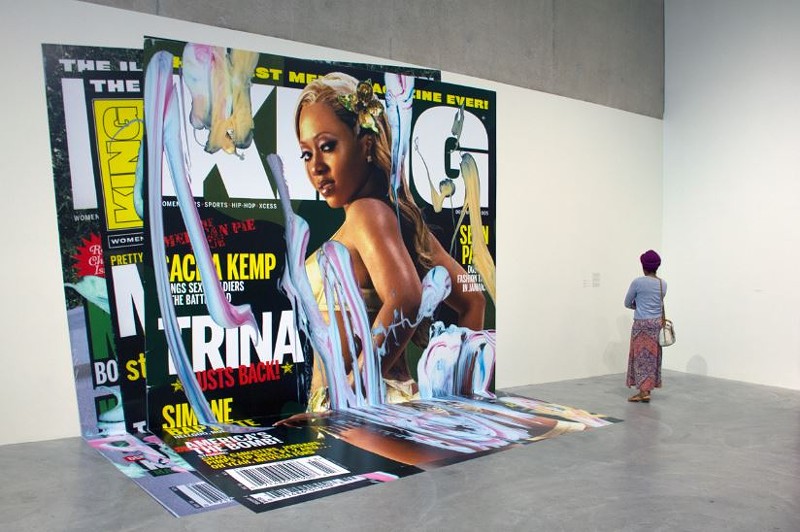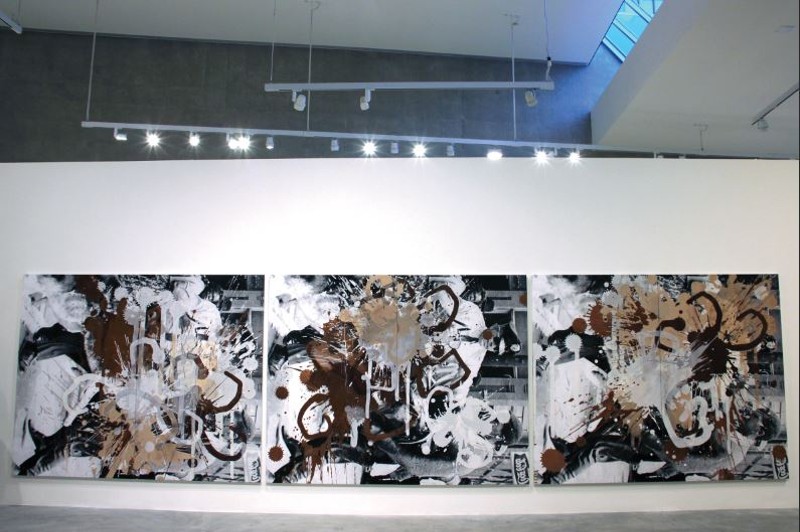
Photo by Danny Wicentowski
One of Kelley Walker's pieces is a scanned print of a King Magazine cover splashed with toothpaste.
The New York City-based gallery representing artist Kelley Walker has responded to the controversy surrounding a racially-charged exhibition at the Contemporary Art Museum-St. Louis, but with a statement that raises more questions than it answers.
In its statement, posted September 21, the Paula Cooper Gallery argues that art requires neither explanation nor defense. Then it suggests that a boycott would amount to censorship. Finally, it awkwardly brings up the police shootings of black men in an apparent suggestion of solidarity. It's quite a mouthful.
In the past two weeks, outrage has spiraled around Walker's "Direct Drive" exhibition at CAM. His use of sexualized pictures of black women and historic images of civil rights struggle, coupled with his conduct at an artist's talk at the museum on September 17, resulted in public calls for a boycott and internal demands for a curator's resignation.
As a whole, the "Direct Drive" exhibition showcasing Walker's work is enormous, comprising nearly 50 pieces and filling the entire museum. But visitors, including a cadre of black artists who attended the September 17 talk, were shocked by two of them: a series of historic photograph from a 1963 protest slathered in chocolate, as well as a floor-to-ceiling print of a King Magazine cover upon which Walker had splattered toothpaste, in jizz-like gobs, across rapper Trina's body.
Damon Davis, a multi-disciplinary artist whose work earned him a spot among RFT's "75 Reasons to Love St. Louis," attended Walker's talk on the 17th. He came away baffled and mad.
"I went to this talk to specifically ask Walker why he chose these images to use and what this art means. When confronted with an actual black person, Walker became flustered and angry and had no actual answer for why he was using these images," Davis wrote in a widely shared Facebook post. "If you are an artist and you are making work that is specifically racially and sexually charged, if you use black people for props in your work, then at least be ready to explain yourself."

Photo by Danny Wicentowski
Walker's Black Star Press is comprised of three chocolate-spattered prints of Bill Hudson's famed 1963 photograph of a protest in Birmingham, Alabama.
The two pieces amounted to shoddy appropriation, not art, Davis argued. He called for a boycott until the museum took down the pieces.
On Monday, CAM announced that it would be modifying the exhibit. No, it would not be removing the controversial works, but would instead erect walls around the two pieces in the flagship exhibition. The museum is also adding informational signs around the enclosure to explain the objections to Walker's work and to provide a warning to those who wish to avoid it.
"I deeply regret that a great deal of anger, frustration and resentment have developed in the St. Louis community as a result of my failure to engage certain questions from the audience during the public lecture at CAM last Saturday," Walker said in a statement, also released Monday. "I have always hoped that these works, and the exhibition as a whole, would provide a forum for a conversation about the way American society gets represented in the media as images shift from context to context (newspapers, magazines, film, TV, etc.) and about how the representation of the body, particularly of the black body, is an exceedingly complex topic in American art and culture."
But Walker still did not take the opportunity to actually engage the questions which he admits he failed to answer. And that strange omission brings us back to his gallery's September 21 statement, which has garnered no media coverage beyond a brief mention in a St. Louis Public Radio followup story.
And it's a shame, because the gallery's statement remains the most full-throated defense of Walker's work as it relates to the St. Louis controversy — even as it utterly fails to grapple with the questions being raised.
In its opening paragraphs, the gallery's statement (which you can read in full below) acknowledges the reality of the "anger of the black community and its challenge to systemic forms of racism" in St. Louis and that "questions of race and representation are sensitive and urgent."
The statement then gets into the meat of its argument: Art is supposed to raise crucial questions, and an artist's mission is merely to ask them.
"The role of the artist, it has been said, is to ask questions, not answer them," the gallery noted in an artful deployment of the passive voice.
The statement continues: "Kelley Walker’s art centers on the use and reuse of images that already circulate in our culture. In the St. Louis exhibition, which presents close to fifty works with imagery as varied as Volkswagen and Benetton ad campaigns, brick walls and sculptures inspired by the recycling logo, two bodies of works have generated concern within the community. They are based on appropriations and alterations of hip-hop magazine covers and documentary photographs from the 1963 civil rights protest in Birmingham. These not only consider our troubled history, but also reflect on the representation of the black body in contemporary culture, as well as open up onto larger issues of power, violence, consumption, and desire."
But by doggedly refusing to answer questions, the gallery dodges any explanation as to how, for instance, a toothpasty money-shot on a black woman reflects representation of the black body. The answer is a shoulder-shrug, a circular argument that maintains that confusion is just another word for "dialogue."
In that view, the actual people in those photographs don't matter. The chocolate-coated photos of a protester being ripped apart by a police dog in Birmingham exist to "consider" America's troubled history. But to consider the protester? That's not art's job.
In a standalone essay published Wednesday, Davis called out this perspective for its presumed elitism and white male privilege. Describing Walker's talk on September 17, Davis said the artist couldn't answer basic questions such as "Who is your audience" and “Why do you call these works paintings, when they are photographs?”
There is no man behind the curtain, no greater meaning to Walker's work, Davis concludes.
"This guy is why the art world is viewed as classist and not for people of color," Davis writes. "This under-planned, poorly executed, elementary level artwork that uses Black women and men as props and controversy starters is over-intellectualized by classist, utterly inept, pompous, and clueless curator types. The world of art gets no more white and privileged than this."
As if proving Davis' point, the gallery's September 21 statement seems to go out of its way to dismiss substantive critiques.
"Art is not one-dimensional, and is always up for debate," the statement continues. "Conversely," it adds, "we stand firmly opposed to calls for a boycott and closing down of the exhibition, which effectively result in shutting down dialogue and are an instance of censorship."
This would seem like a natural place to end things. Instead, the statement concludes by pointing out how "shortly before this controversy unfolded," an unarmed black man named Terence Crutcher was shot to death by a Tulsa, Oklahoma, police officer. (The officer has since been charged with first-degree manslaughter.)
"We extend our condolences to the family of Terence Crutcher and stand in solidarity with those seeking justice, accountability and an end to racially-motivated violence in this country."
What to make of this jarring declaration of solidarity? No one ever accused the gallery of not caring about Crutcher, let alone any past instance of police shooting unarmed black people. Perhaps the gallery was just trying to reassure everyone that, despite its support for artwork criticized for racial exploitation, it's still totally against racism.
We can't say. The gallery directed all our questions about its statement and Walker's exhibit back to CAM.
Here's the full statement, which can also be found on the Paula Cooper Gallery website:
The Kelley Walker exhibition Direct Drive, which opened at the Contemporary Art Museum in Saint Louis, has come under fire from members of the St. Louis community for its representation of black men and women in some of the works on display. The uproar followed an exchange between Walker, exhibition curator Jeffrey Uslip and community activist and artist Damon Davis during a public lecture. Details about the controversy can be found in the links below. Davis has called for a boycott of the museum until the exhibition is taken down.
The anger of the black community and its challenge to systemic forms of racism, in St. Louis and elsewhere in the US, is real. Questions of race and representation are sensitive and urgent, particularly when seen within the context of decades of violence and disenfranchisement, punctuated by a seemingly endless string of tragedies. We believe, however, that it is positive for this difficult conversation to occur, as we firmly believe in art’s power to ask crucial questions about our times, and in its potential to elicit a multiplicity of responses and points of view. We trust that CAM will provide a safe and welcoming space for this conversation to take place and for this multiplicity of voices to be heard.
The role of the artist, it has been said, is to ask questions, not answer them. Kelley Walker’s art centers on the use and reuse of images that already circulate in our culture. In the St. Louis exhibition, which presents close to fifty works with imagery as varied as Volkswagen and Benetton ad campaigns, brick walls and sculptures inspired by the recycling logo, two bodies of works have generated concern within the community. They are based on appropriations and alterations of hip-hop magazine covers and documentary photographs from the 1963 civil rights protest in Birmingham. These not only consider our troubled history, but also reflect on the representation of the black body in contemporary culture, as well as open up onto larger issues of power, violence, consumption, and desire.
Art is not one-dimensional, and is always up for debate. Race-related issues in Walker’s art have been discussed by a number of artists and critics; indeed, in this exhibition’s catalogue an essay by Hilton Als further addresses these very issues. It is the artist’s and the gallery’s wish that Direct Drive may provide the impetus for a renewed and much needed dialogue about race and representation, in St. Louis and elsewhere. Conversely, we stand firmly opposed to calls for a boycott and closing down of the exhibition, which effectively result in shutting down dialogue and are an instance of censorship.
Throughout its history, the Paula Cooper Gallery has been unequivocal in its support of progressive causes, including racial justice and equality, and in its rejection of all forms of reactionary politics, including the suppression of an artist’s voice.
Last Friday, shortly before this controversy unfolded, yet another unarmed black man was fatally shot by police in Tulsa, Oklahoma. We extend our condolences to the family of Terence Crutcher and stand in solidarity with those seeking justice, accountability and an end to racially-motivated violence in this country.
Follow Danny Wicentowski on Twitter at @D_Towski. E-mail the author at [email protected]





